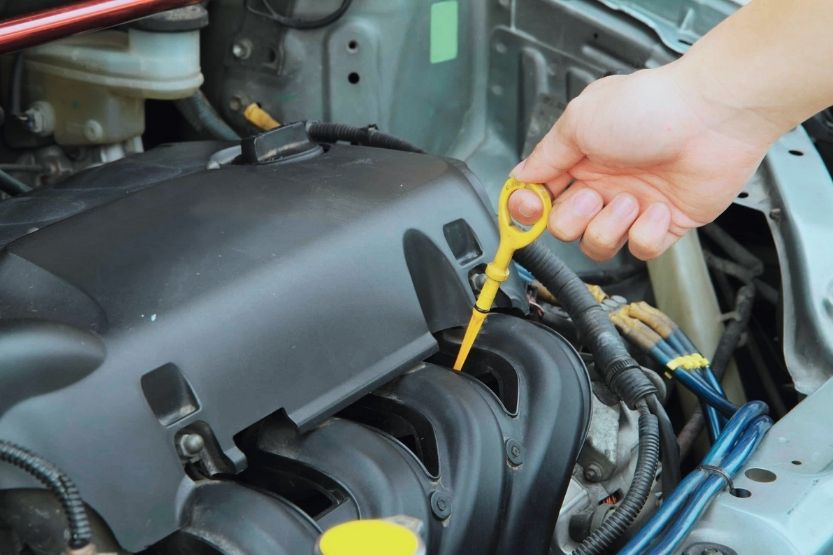Has your vehicle had an oil change recently? Let’s face it; not all car owners follow their car’s maintenance schedule. So, how long can you go without an oil change after the light comes on?
If your car’s oil warning light turns on, you still have roughly 500 miles of driving before your car encounters issues. That’s about two weeks of driving. If you continue to ignore this, you will undoubtedly encounter severe mechanical damage. So, it is always best to seek help from a professional mechanic once the oil light comes on.
Read on to learn more about how long you can go without an oil change and the oil change warning light.
How Long Can You Go Without an Oil Change After the Light Comes On?

If your vehicle’s oil warning light turns on, you have roughly 500 miles of driving before your car encounters issues. That’s about two weeks of driving.
If you continue to ignore it, your car will surely encounter severe mechanical damage. So, it is always recommended to seek help from a professional mechanic once the oil light turns on.
Overdue Oil Change Symptoms
You are not supposed to ignore it once your vehicle is due for an oil change. Knowing when it is due is convenient if you have a modern vehicle since the oil warning light is hard to ignore.
Most older vehicles don’t come with an oil warning light. In this case, you have to monitor your mileage or subject your vehicle to an oil change every 3 to 6 months. It’s not that hard to monitor it too.
Here are several overdue oil change symptoms you may encounter:
- Service Warning Lights
- Low Oil Level
- Stalling Engine
- Dirty or Dark Oil
- Poor Fuel Economy
- Dark Exhaust Smoke
- Overheating Engine
- Burning Oil Smell
1. Service Warning Lights
If your car’s oil warning light turns on, it needs an oil change. Again, newer car models have warning lights. So, it’s quite hard to miss this.
Other warning lights will tell you that your car has low oil pressure or overheating. But a “check engine” light is enough to tell you that your car is due for an oil change.
2. Low Oil Level
It’s fairly easy to check your vehicle’s oil manually. Take out the dipstick and wipe it clean. Then, stick it back in.
On the second check, observe the fluid level. If it seems too low, your car is most likely due to an oil change. It is also possible that you need to top off your car’s fluid. Also, observe if there is an oil leak as it could also be the reason for having a low oil level.
3. Stalling Engine
Does your car’s engine seem to seize up from time to time? Or does it stall, especially during cold weather conditions? If yes, your car might have a low engine, an oil leak, or bad oil.
In this case, it is best to have your car checked by a professional. A vehicle needs an oil change to address this issue most of the time.
4. Dirty or Dark Oil
Using your car’s dipstick, you will also be able to tell the quality of your oil. A dirty, milky, or dark oil is a sign that your car is already overdue for an oil change.
5. Poor Fuel Economy
If clean oil is not enough, it will affect the engine performance. You will surely notice a decline in fuel efficiency, which might be a sign of other problems:
- Exhaust system
- Engine
- Fuel system
6. Dark Exhaust Smoke
Dark exhaust smoke may mean low or dirty oil that affects the engine. However, it can also mean a catalytic converter problem or an exhaust leak. Whichever it is, you should bring your car to a professional mechanic to have it checked.
7. Overheating Engine
If your vehicle is not receiving enough clean oil, it will not run efficiently. So, when your car’s engine overheats, it most likely results from an overdue oil change.
But it is possible too that the issue is with the cooling system. Again, it is recommended to have your car checked by a professional if you encounter this issue.
8. Burning Oil Smell
If you smell burning oil while driving, then it is a sign that your car needs an oil change as soon as possible.
What Happens If You Wait Too Long for an Oil Change?

All car manufacturers highly advise car owners to regularly subject their vehicles to an oil change. Remember that oil has several functions, including:
- Engine protection,
- Keeps the engine clean and
- Engine cooling.
Here are some car issues you will encounter if you don’t change your motor oil:
- Components Will Wear Off
- Dirt Will Build Up
- Engine Will Overheat
- Voided Car Warranty
- Increased Fuel Consumption
1. Components Will Wear Off
A car engine features several moving parts. These include valves and pistons. The lubricating properties of your car’s engine oil reduce friction. Therefore, it plays a vital role in protecting those parts.
Engine Oil Will Deteriorate
If you miss your car’s oil change schedule, the engine oil will continue to deteriorate. It will fail to protect the engine’s components from friction fully. This will then wear off components until they get completely damaged.
Major Car Issues
So, if you are asking, can you go a year without an oil change? This might be impossible. After a year or just a few months, you will likely encounter major car issues.
2. Dirt Will Build Up
Helps Remove Small Debris and Particles
The motor oil also helps clean the engine by removing small debris and particles. If your car misses its oil change schedule, it will likely result in dirt buildup.
Plug Oil Channels and Shorten Engine Life
This can then plug oil channels and shorten engine life. Dirt buildup prevents the engine from working efficiently. It can even lead to loss of power.
Sludge Formation
If the motor oil is not changed for a long time, it will gel or solidify in the car’s engine. It will eventually turn into sludge. This will prevent the oil from reaching different parts of the engine. There will be oil starvation in the camshafts, bearings, and crankshafts.
The oil will not reach other valve train components. The last thing you would want to happen is a damaged engine that must be replaced immediately.
3. Engine Will Overheat
Plays an Important Role in Cooling the Engine
If you didn’t know, motor oil also plays a vital role in cooling the engine. The coolant system is not the only part of your vehicle that cools the engine. Interestingly, the motor oil is capable of reaching places that the coolant system can’t reach.
Thicker Due to High Temperatures
But if the oil or its quality deteriorates, its viscosity becomes thicker due to exposure to high temperatures. It then becomes incapable of absorbing heat and tends to allow the engine to overheat. Aside from that, the gaskets can also blow up and other parts to wear and tear.
4. Voided Car Warranty
If you don’t follow the recommended maintenance schedule of your vehicle, its warranty will be voided. This is because there is negligence on your part as a vehicle owner.
Without following the recommended maintenance, your car will encounter engine issues. This will result in higher costs and, unfortunately, your car manufacturer will not reimburse it.
5. Increased Fuel Consumption
Hard Time Running Due to Thicker and Dirtier Oil
If the oil becomes thicker and dirtier, the engine will have a hard time running. Because of this, your car will most likely require you to put in more fuel often to produce the same amount of power. However, your car will release toxic smoke resulting from burned engine oil.
Cheaper to Replace Engine Oil Than Have the Car Repaired for Damages
Having your car’s oil changed may cost you some money. But, the truth is, it is way cheaper than having its engine repaired for serious damages.
If you have your car serviced accordingly, your car will continue to have strong engine performance. At the same time, the engine can even prolong its life span.
Again, how long can you go without an oil change after the light comes on? Allow a mechanic to inspect your car when the oil light is on. Also, avoid driving for too long when this light is illuminated. You only have about two weeks or around 500 miles until the problem worsens.
How Many Months Can You Go Without an Oil Change?

Once the oil warning light comes on, make sure to have your car’s oil changed as soon as possible. Some say that they have a busy schedule and can’t bring their car immediately to an auto care shop.
If so, you still have roughly two weeks of “grace period,” which is about 500 miles of driving. Sadly, if you still don’t get to have an oil change within that period, your car will most likely start encountering engine issues.
So, if you are asking, how many months can you go without an oil change? It might not be that long until you start to notice engine failure.
Benefits of Regular Oil Change
You’ll surely reap the benefits when you subject your vehicle to its regular oil change schedule. So, what are these benefits? They are the following:
- Engine Efficiency
- Better Mileage
- Engine Protection
- Eco-Friendliness
- Worry-free Emission Tests
- Engine Components Are Kept Cool
- Extended Engine Lifespan
1. Engine Efficiency
Changing your car’s engine oil regularly does not only keep the engine clean. But it also maintains strong engine performance.
If not regularly replaced, the oil becomes thicker and dirty. This will result in poor engine performance and, sadly, engine breakdown.
2. Better Mileage
Your vehicle will surely get the best mileage when traveling when an engine runs efficiently. To make this happen, you have to maintain a clean engine which you can achieve with a regular oil change.
Fresh engine oil does not only improve engine performance. It also helps in utilizing fuel more efficiently. It is also cost-efficient, aside from getting better gas mileage.
3. Engine Protection
If you maintain fresh oil in your car’s engine, you will prevent it from having excess wear and tear. You will also avoid the buildup of sludge and friction from happening.
Suffice to say that you will be able to protect your engine from any serious damage. Therefore, allowing it to run efficiently and conveniently.
4. Eco-Friendliness
Not having an oil change does not only damage your car. But it also damages the environment.
When driving your car, heat causes the quality of the engine oil to decrease. Also, heat releases gas. So, if the oil is not enough or has poor quality, the gas released from your vehicle will include hydrocarbons. Unfortunately, these are harmful and toxic to the environment.
With fresh engine oil, you will prevent your car from polluting the air.
5. Worry-free Emission Tests
Regular oil changes mean your car will consistently run smoothly too. This lessens, if not eliminates, your worry every time your vehicle undergoes emission tests. Your vehicle will surely pass them without encountering any hassle.
6. Engine Components Are Kept Cool
Engine components will generate too much heat when you drive at high speeds. With fresh oil, there will be proper lubrication and minimal friction. This will prevent engine components from overheating.
7. Extended Engine Lifespan
Dirty and insufficient amounts of oil will surely result in serious engine damage. But if your car undergoes regular oil changes, it will not only maintain its strong engine performance. But you will also be able to extend the life of your car.
Frequently Asked Questions – How Long Can You Drive with the Oil Light On?
Here are some frequently asked questions about the importance of oil change to your vehicle:
How Long Can You Drive with the Oil Light On?
Once the oil warning light turns on, make sure to have your vehicle serviced soon. You can still drive it safely for about two weeks, about 500 miles of driving. But if you continue to delay its oil change schedule, your engine will likely start encountering irreparable damages.
Is It Safe to Drive with Oil Change Light On?
It is not advisable to drive with the oil warning light on because it can result in severe engine damage. So, once it lights, make sure to squeeze in some time for an oil change as soon as possible.
How Long Can You Go Without an Oil Change after Its Due?
Once the oil warning light comes on, your vehicle can still run 5,000 to 6,000 miles if your engine can tolerate it. It is also possible for it to run 10,000 miles, but it all depends on the age of your vehicle.
It also all depends on your driving habits. But you must also anticipate severe engine damages if you continue to delay your vehicle’s oil change schedule.
What Happens If Oil Change Is Overdue?
A long-delayed oil change will turn the oil into dirty sludge. The engine loses its lubrication, diminishes heat absorption, and becomes prone to significant engine damage.
What Happens When Oil Light Comes on and Off?
Your oil sensor may have a problem, or the oil pressure is too low if the oil warning light flickers on and off. If the vehicle is idle, the PSI should be 5. Anything lower than that will cause the oil light to flicker on and off.
How Long Can You Drive with the Engine Light On?
Once the Check Engine Light turns on, it is possible to still drive the car for hundreds of miles without encountering engine issues.
Can I Go 1000 Miles over My Oil Change?
Engine design and oil technology have undergone many advancements. Today, modern vehicles can run 5,000 to 10,000 miles between oil changes. You can ensure your car’s engine performance by following the oil change interval recommended by your car manufacturer.
What Happens If You Don’t Change Your Oil for Two Years?
The existing engine oil will gel and turn into sludge without an oil change. This will result in oil starvation in different engine components. These components include camshafts, bearings, and crankshafts.
What Happens If You Don’t Change Your Oil for 10000 Miles?
Oil change intervals vary, depending on the type of vehicle and oil. Typically, it ranges between 3,000 and 10,000 miles. So, make sure to check the oil change interval recommended by your car manufacturer. Hopefully, your engine is still good after 10,000 miles.
But if you continue to ignore your vehicle’s oil change schedule, your engine will most likely not last that long. Aside from that, the repairs will be way more expensive than any oil change service.
Conclusion – How Long Can You Go Without an Oil Change After the Light Comes On?
So, let’s sum up everything you need to know about oil change.
If your vehicle’s oil warning light turns on, you still have about 500 miles of driving before encountering issues. That’s about two weeks of driving.
If you continue to ignore it, your car will surely encounter severe mechanical damage. So, it is always recommended to seek help from a professional mechanic once the oil light turns on.
If you want to avoid any engine issues, follow the oil change interval recommended by your car manufacturer. This way, you will prevent irreparable damages from happening.
Most importantly, you will be able to use your vehicle for many years. It can even impressively be of service to you longer than expected.
Read next:
Can You Mix Oils of Different Viscosity and Weight?



![Check Engine Light on After Oil Change [Causes and Solutions] Check Engine Light on After Oil Change](https://roadsumo.com/wp-content/uploads/2021/10/check-engine-light-on-after-oil-change-150x150.jpg)
![How to Start a Car Without a Key [Turn Ignition Without Key] how to start a car without a key](https://roadsumo.com/wp-content/uploads/2021/06/how-to-start-a-car-without-a-key-150x150.jpg)



![Read more about the article Amsoil Vs Mobil 1 [Which is the Better Engine Oil?]](https://roadsumo.com/wp-content/uploads/2021/04/Amsoil-vs-Mobil-1-300x200.jpg)
